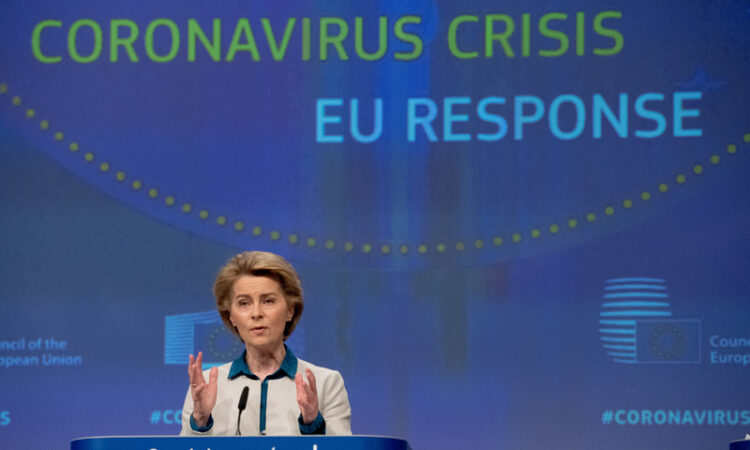
The EU Commission’s €723bn pandemic economic reconstruction fund came up for its mid-term appraisal on Wednesday (21 February).
And perhaps unsurprisingly, commission officials gave the so-called Reconstruction and Resilience Facility (RRF) a favourable review.
“The RRF has succeeded in its immediate ambition: to help member states recover faster from the harsh social and economic impact of the Covid-19 pandemic,” said trade commissioner Valdis Dombrovskis.
When purely looking at growth figures, the extra spending has helped speed up growth. But it has been less effective than initially estimated.
In 2020, when the plan was launched, modellers forecasted GDP to grow by 1.9 percent two years after launch.
Independent modellers have since estimated the actual figure closer to 0.4. The commission itself applied the Quest model, which puts the average growth gains of the plan at 0.8 percent in 2022.
Why so low?
But economy commissioner Paolo Gentiloni made the case on Wednesday that solely focusing on models misses the true impact of the plan.
“It is crucial to remember that the European recovery in 2022 was impressive,” Gentiloni said. “Growth was stronger than in the US and China.”
Gentiloni has been a staunch defender of the plan, which gave the commission significant financial firepower for the first time, and hopes it can be repeated in the future for other EU common goals, such as defence fund, despite resistance from some member states.
The extra investment of the commission, combined with the €1,800bn bond-buying programme of the European Central Bank, indeed have contributed to the economic stability during tough crisis years.
Therefore, commission officials have insisted that the lower-than-expected GDP effects are in large part a consequence of external economic and geopolitical shocks.
For one, inflation has cut into the actual value of the fund. Another reason is that while member states have requested all the grant money [which comes to €338bn], some €91bn of the total €385bn in loans, which makes up the rest of the package, will not be spent.
“We assumed everything would be used, but since that is not the case, the actual size of the fund is smaller,” said Gentiloni.
A final reason offered is a slower-than-expected implementation of the plan. This has to do with the Russian invasion of Ukraine, commission officials indicated.
The ensuing energy crisis forced countries to revise existing plans to weave in more energy investments under the EU energy security vehicle (€40bn in loans and €20bn additional grants under RepowerEU), which caused further delays.
2026 deadline
This has created another challenge, because all funds must be taken up by the 2026 deadline according to the plan’s rules.
After this, no more money can be drawn from the plan — a limitation insisted on by some member countries, including Germany, to ensure the fund is only temporary.
EU commission officials expect the uptake out of the fund to double this year compared to last year.
According to commission estimates, the RRF will translate into an extra 1.4 percent GDP growth by the end of the programme if member states take up most, if not all, of the money.
Some countries are expected to benefit even more. The Italian GDP economy will grow an extra three percent and the Croatian economy by four percent by 2026.
“I think we will make it,” said Gentiloni.
But Bulgaria, for example, has only implemented two percent of their green plans. And Latvia only 2.3 percent at this half-way point, which is starting to raise doubts about the feasibility of the undertaking.
According to CEE Bankwatch Network, a global NGO, the commission painted an “overly positive picture” of how public money has been spent.
The recovery fund “was initially a breath of fresh air,” said Christophe Jost, who is a senior policy officer at CEE Bankwatch Network. “But implementation has proved complex. Now, there is a real risk that not all of the objectives will be achieved.”
With pressure to spend quickly, the risk governments are starting to cut corners is real, which is exacerbated by weak monitoring that relies almost exclusively on targets set beforehand to measure the impact on the ground. “It is incredibly difficult to assess the impact on the ground,” CEE Bankwatch noted.
EU officials have admitted to this. “The association of stakeholders and civil society could have been better,” said an EU official speaking anonymously and described monitoring as a “light touch.”
“We need to see more detailed and transparent monitoring of the measures and debate the future of EU funding after 2026,” said Jost.
According to commission president Ursula von der Leyen, the plan “is tackling national challenges and fast-tracking our common priorities for a green, inclusive, digital, resilient and competitive EU.”
On a relatively positive note, the Zoe Institute for Future-Fit Economies, a non-profit active in Brussels, calculated that most EU countries improved their economic resilience since 2019 despite ensuing crises.
“The EU’s cash injection to bolster economic resilience after the pandemic seems to be working,” said Lydia Korinek, a policy consultant at ZOE Institute. “EU economies have performed surprisingly well given the difficulties they’ve faced in the last years.”
Still, promises of inclusivity, improved gender equality and economic participation often touted by commission officials as one of the benefits of the fund seem overblown at best.
The focus on headline economic figures “masks” that there is still “a lack of measures to address social cohesion,” said Korinek.
Looking ahead, Gentiloni insisted the EU will need another fund to help member states invest in common goals such as defence.
“The OECD, the ECB and the IMF have all recommended that we need it,” he said.






